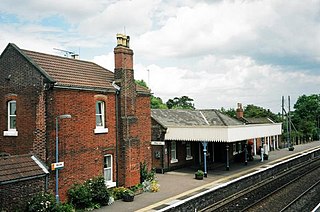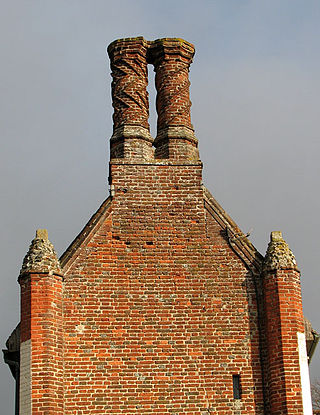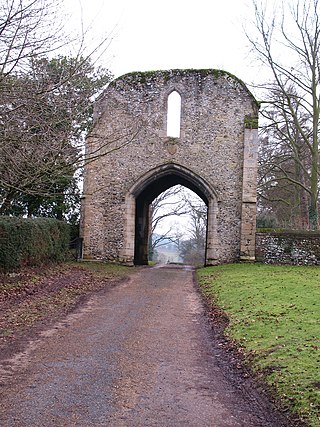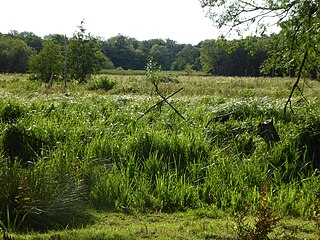Notes
52°38′51″N1°34′06″E / 52.6475°N 1.5684°E
Weybridge Priory was an Augustinian priory in Acle, Norfolk, England, that was founded in the early 12th century, at some distance from the centre of the village, but next to an important ford over the River Bure. It was dissolved at the dissolution of the monasteries, and its stones were removed for local secular buildings to such an extent that the site of the priory is sometimes mistaken. [1]
52°38′51″N1°34′06″E / 52.6475°N 1.5684°E

Acle is a market town on the River Bure on the Norfolk Broads in Norfolk, located halfway between Norwich and Great Yarmouth. It has the only bridge across the River Bure between Wroxham and Great Yarmouth.

Acle railway station is on the Wherry Lines in the east of England, serving the town of Acle, Norfolk. It is 10 miles 34 chains (16.8 km) down the line from Norwich on the route to Great Yarmouth. Its three-letter station code is ACL.

Thetford Priory is a Cluniac monastic house in Thetford, Norfolk, England. Founded in 1103 by Roger Bigod of Norfolk, Thetford was one of the most important monasteries of East Anglia.
According to 19th-century directories, Nowhere or No-Where is a marshy area by the River Bure where the villagers of Acle, Norfolk had salt-pans to produce salt for food preservation, etc. In 1861 there were four inhabited houses and 16 people.

Coxford Priory or Broomsthorpe Priory was a monastic house in Norfolk, England.

Crabhouse Priory was a medieval monastic house in Norfolk, England.
Hickling Priory was an Augustinian priory located in Norfolk, England.

The Benedictine Priory, King's Lynn, was a medieval monastery in Norfolk, England. It was founded in 1100 in King's Lynn by Herbert de Losinga, bishop of Norwich, as a small monastic house supporting the church of St Margaret founded at the same time. Its rents and profits were remitted for the use of the priory of the Holy Trinity which served Norwich Cathedral, also founded around the same time by Bishop Herbert. The priory at King's Lynn was lucrative for many years but towards the end of its existence the income from it had fallen to less than the cost of maintaining it.
Modeney Priory—also spelled Modney and Modeny—was a Benedictine priory in the civil parish of Hilgay, Norfolk, England. Located less than a mile east of the River Great Ouse, Modeney Priory was a cell of Ramsey Abbey. Modeney Priory was founded before 1291 and dissolved c. 1536. Its former location is now occupied by Modney Hall farmhouse. According to field research undertaken by Historic England in 1976: "There are no surface structural remains of the priory. Modney Hall has an 18th/19th century brick cased exterior, but according to a former owner parts of the interior date to the 15th [century]."

The Priory of St Mary de Bello Loco, commonly referred to as Molycourt Priory, was a small Benedictine priory located in the parish of Outwell, Norfolk, England.

Old Buckenham Priory was an Augustinian priory built on the site of Old Buckenham Castle at Old Buckenham in Norfolk, England.

Pentney Priory was an Augustinian priory at Pentney in the district of King's Lynn and West Norfolk, Norfolk, England. The ruins of the priory, mostly comprising the flint-built gatehouse, are Grade I listed.

Holy Sepulchre Church was a medieval monastic house in Thetford, Norfolk. The ruined nave of this 14th-century church are the only surviving remains in England of a priory of Canons of the Holy Sepulchre, who followed the Rule of Saint Augustine and aided pilgrims to Christ's tomb. It was later used as a barn, and is a Grade I listed building.

West Acre Priory of St. Mary and All Saints was a medieval monastic house at West Acre in the King's Lynn and West Norfolk district of Norfolk, England founded c.1100 by the de Toni family. Later an Augustinian fraternity, it was closed down in 1538 as part of the Dissolution of the Monasteries under King Henry VIII. It is now a ruin with no intention of being repaired.

Weybourne Priory was a small Augustinian medieval monastic house in Weybourne, Norfolk, England.
Snape Priory was a priory in Suffolk, England. It was founded as a cell of the Benedictine St John's Abbey, Colchester in Essex.

Brundall signal box is a Grade II listed former Great Eastern Railway signal box on Brundall railway station in Norfolk, England.

Damgate Marshes, Acle is a 64.7-hectare (160-acre) biological Site of Special Scientific Interest between Norwich and Great Yarmouth in Norfolk. It is part of the Broadland Ramsar site and The Broads Special Area of Conservation.

Decoy Carr, Acle is a 56-hectare (140-acre) biological Site of Special Scientific Interest south of Acle in Norfolk. It is part of the Broadland Ramsar site and Special Protection Area, and The Broads Special Area of Conservation.
Slevesholm Priory was a Cluniac priory in the civil parish of Methwold, Norfolk, England, that was dedicated to St. Mary and St. Giles. A cell of the Castle Acre Priory, Slevesholm Priory was either granted by William de Warenne, 5th Earl of Surrey between 1222-6 or established during the reign of king Stephen (1135–1154), and dissolved in 1537 during the dissolution of the monasteries. There are no extant remains of the priory; Historic England undertook field research in 1976 and remarked: "There are no physical remains of this [priory] at the formerly published site which is now under plough; farm workers questioned had no knowledge of early finds or foundations. [There is] impression of early quarrying [while] no recognisable pattern is evident and there is no surface trace of building material."